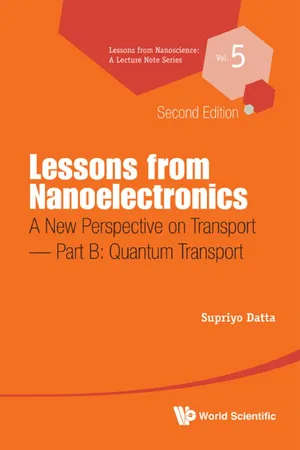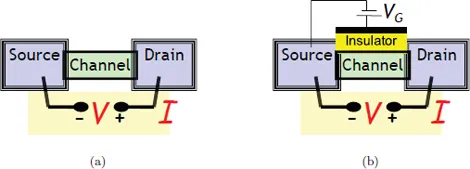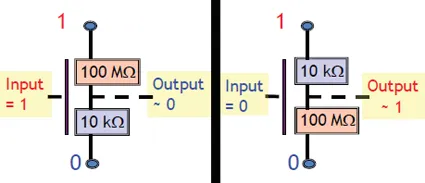
Lessons from Nanoelectronics
A New Perspective on Transport — Part B: Quantum Transport
- 260 pages
- English
- ePUB (mobile friendly)
- Available on iOS & Android
Lessons from Nanoelectronics
A New Perspective on Transport — Part B: Quantum Transport
About this book
-->
Everyone is familiar with the amazing performance of a modern smartphone, powered by a billion-plus nanotransistors, each having an active region that is barely a few hundred atoms long. The same amazing technology has also led to a deeper understanding of the nature of current flow and heat dissipation on an atomic scale which is of broad relevance to the general problems of non-equilibrium statistical mechanics that pervade many different fields.
This book is based on a set of two online courses originally offered in 2012 on nanoHUB-U and more recently in 2015 on edX. In preparing the second edition the author decided to split it into parts A and B titled Basic Concepts and Quantum Transport respectively, along the lines of the two courses. A list of available video lectures corresponding to different sections of this volume is provided upfront.
To make these lectures accessible to anyone in any branch of science or engineering, the author assume very little background beyond linear algebra and differential equations. However, the author will be discussing advanced concepts that should be of interest even to specialists, who are encouraged to look at his earlier books for additional technical details.
-->
-->
Contents:
- Preface
- Acknowledgments
- List of Available Video Lectures Quantum Transport
- Constants Used in This Book
- Some Symbols Used
- Overview
- Contact-ing Schrödinger:
- The Model
- NEGF Method
- Can Two Offer Less Resistance than One?
- More on NEGF:
- Quantum of Conductance
- Inelastic Scattering
- Does NEGF Include "Everything?"
- Spin Transport:
- Rotating an Electron
- Quantum to Classical
- Epilogue: Probabilistic Spin Logic (PSL)
- Appendices:
- List of Equations and Figures Cited From Part A
- NEGF Equations
- MATLAB Codes Used for Text Figures
- Table of Contents of Part A: Basic Concepts
- Available Video Lectures for Part A: Basic Concepts
-->
--> Readership: Students and professionals in any branch of science or engineering. -->
Keywords:Nanoelectronics;Transport;Theory;Spintronics;Thermoelectricity;Entropy;NanotransistorReview: Key Features:
- Based on a physically insightful approach that not only conveys the key concepts of nanoelectronics, but also their relevance to other non-equilibrium problems like heat flow, spin flow and entropy flow
- The chapters are keyed to video lectures from the online courses offered on nanoHUB-U and on edX
- The author received the 2008 IEEE Technical Field Award for graduate teaching "for his unique approach to quantum transport that has inspired and educated graduate students in the field of nanoscale electronic devices"
Frequently asked questions
- Essential is ideal for learners and professionals who enjoy exploring a wide range of subjects. Access the Essential Library with 800,000+ trusted titles and best-sellers across business, personal growth, and the humanities. Includes unlimited reading time and Standard Read Aloud voice.
- Complete: Perfect for advanced learners and researchers needing full, unrestricted access. Unlock 1.4M+ books across hundreds of subjects, including academic and specialized titles. The Complete Plan also includes advanced features like Premium Read Aloud and Research Assistant.
Please note we cannot support devices running on iOS 13 and Android 7 or earlier. Learn more about using the app.
Information


















Table of contents
- Cover
- Halftitle
- Series Editors
- Title
- Copyright
- Dedication
- Preface
- Acknowledgments
- List of Available Video Lectures Quantum Transport
- Constants Used in This Book
- Some Symbols Used
- Contents
- 1. Overview
- Contact-ing Schrödinger
- More on NEGF
- Spin Transport
- Appendices
- Index